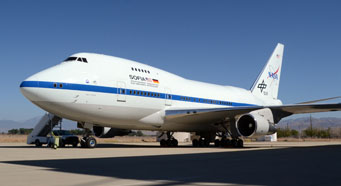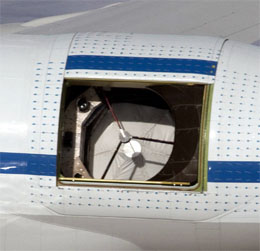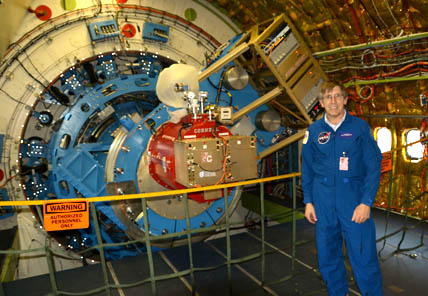NASA's Stratospheric Observatory for Infrared Astronomy (SOFIA) will be critical to understanding the far-infrared universe. Its flight team is still ramping up toward full operation, as demonstrated on a recent flight.
I've had an email folder labeled "SOFIA Flight" for about three years. That's how long I've been trying to ride aboard NASA's Stratospheric Observatory for Infrared Astronomy. As I've noted in past postings — here and here, for example — SOFIA is an observatory like no other.

SOFIA, the Stratospheric Observatory for Infrared Astronomy, is a converted 747SP aircraft. Here's how it looked on June 13, 2013 — hours before the author took a (quick) ride on board.
J. Kelly Beatty
Over the past 16 years, NASA and the German Space Agency (DLR) have partnered to convert a Boeing 747SP aircraft into a globetrotting platform for infrared astronomy. The craft routinely operates in the lowest part of the stratosphere, upward of 40,000 feet (12 km), which puts it above 99.9% of the atmosphere's infrared-blocking water vapor. When it's time to observe, a giant door in the port-side fuselage slides open so that a 8.2-foot (2.5-m) telescope can peer directly into space.
I'm quirkily fascinated with airborne astronomy, so I've been lobbying long and hard for a chance to ride SOFIA. I want to watch how astronomers use its 17-ton telescope to collect far-infrared light from the celestial targets, deal with motions on an aircraft skimming through the lower stratosphere, and acclimate to a noisy observing platform with really tiny bathrooms and no coffee carts.
To this point my efforts have been frustrated by bad luck. I had three chances to ride SOFIA in 2011. Too much rain scrubbed the first attempt, and a schedule mismatch forced me to abandon the second. For the third try, I headed to SOFIA's home base, NASA's Dryden Aircraft Operations Facility in Palmdale, California, and completed all the requisite preflight training for that evening's flight. Then it snowed — in the Mojave Desert! The flight was canceled because DAOF, understandably, has no snowplows.

SOFIA's German-built telescope can be seen in its fuselage cavity during this test flight on December 18, 2009.
NASA / Carla Thomas
My ongoing misfortunes had become a small source of amusement for the flight team at DAOF. SOFIA was grounded throughout 2012 for a series of equipment and electronics upgrades, after which public-affairs officer Beth Hagenauer redoubled her efforts to get me on a flight this summer.
Finally, everything fell into place for a science run on the night of June 13th. I had a good feeling about this opportunity. That same week, 25 years ago, I'd flown aboard SOFIA's predecessor, the Kuiper Airborne Observatory, with a group of MIT astronomers led by the late Jim Elliot. The KAO was flown over the South Pacific to position it to watch Pluto briefly occult a star, and Elliot's team discovered that the Most Famous Dwarf Planet has a thin atmosphere.
Eager as ever, I flew to California, passed a flight physical, and absorbed multiple sessions on inflight safety and evacuation procedures. But my enthusiasm dimmed a bit during SOFIA's preflight briefing. It turned out we would not be making never-been-done-before observations of a half dozen young stellar clusters and nascent star-forming regions, as I'd hoped. Instead, due to delays from the previous week, SOFIA would be trained instead on a series of calibration stars. Bummer.
I took my seat for takeoff in what's left of the 747's original first-class cabin. Sharing the ride were two other reporters and a quartet of educators, along with a dozen NASA, USRA, and Cornell personnel. Sunset was gorgeous as we soared eastward toward the Arizona border, where we'd start the first of five long legs that zigzagged over the Southwest and over the Pacific off the California coast.

The author poses with the business end of SOFIA's optical train. The telescope itself is in a cavity on the other side of the circular bulkhead. The red enclosure at center houses the FORCAST infrared imager, and a large counterweight extends to its upper right.
J. Kelly Beatty
Attached to SOFIA was an imager called FORCAST, short for Faint Object Infrared Camera for the SOFIA Telescope, that can record a 3.2-arcminute-square field at 13 filter-specific wavelengths from 5 to 37 microns. FORCAST is one of seven "first generation" instruments for SOFIA, and its Cornell development team is tying off loose ends before turning the keys over to the Universities Space Research Association, which will operate SOFIA for the first 5 years of its expected 20-year lifetime.
After passing through 30,000 feet, mission manager Charlie Kaminski made the call to slide open the giant barrel door in the fuselage. I expected to hear a deep-throated whoosh or feel some vibration to indicate that air was rushing past a 13½-by-18-foot hole in the plane's side at mach 0.85. Surprisingly, nothing like that happened — in fact, the only indication that the door really had opened was a graphic on Kaminski's computer monitor.
But it didn't stay open for long. The cockpit crew upstairs was eyeing low oil pressure in engines 1 and 4. One warning light would have been tolerable, but two of them — combined with the upcoming legs out over open ocean, meant we were done for the night. We turned around, landed, deplaned, and headed to a nearby watering hole to commiserate.
So I'm 0-for-4 on SOFIA. I've been invited to take another flight, maybe soon, but the NASA folks want to make sure this one, finally, will be a complete success. I'll do whatever it takes to make that happen — and there's already been talk of putting a bag over my head next time to hide my identity.
 4
4
Comments
Peter Wilson
June 19, 2013 at 4:35 pm
Reminds me of dark energy...
You must be logged in to post a comment.
Anthony Barreiro
June 21, 2013 at 3:05 pm
Kelly, you went up to 30,000 feet on SOFIA and they opened the fuselage! You got a picture standing next to the telescope! I'm sure your next flight will be longer and more productive, but you've already done more stratospheric observation than the rest of can hope to do in our lifetimes.
You must be logged in to post a comment.
Jim Manley
June 29, 2013 at 2:12 am
Hey Kelly,
Great report, but you got one small detail wrong about a large opening. The telescope peers out through the opening in the PORT (left) side of the fuselage, aft of the wing on that side, not the starboard side.
I've had a folder with SOFIA on its label for even longer than you. I'm hoping to be one of the educators selected to fly in 2014, who are supposed to be announced by the end of June 2013.
All the Best,
Jim
You must be logged in to post a comment.
Kelly Beatty
July 2, 2013 at 5:38 pm
Jim... right you are. nit corrected! and good luck getting a flight.
You must be logged in to post a comment.
You must be logged in to post a comment.